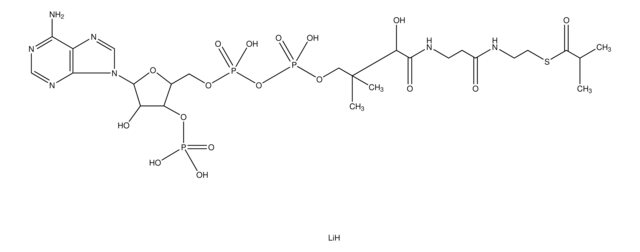O1012
Oleoyl coenzyme A lithium salt
≥90% (HPLC)
Synonym(s):
cis-9-Octadecenoyl coenzyme A
Sign Into View Organizational & Contract Pricing
All Photos(1)
About This Item
Empirical Formula (Hill Notation):
C39H68N7O17P3S
CAS Number:
Molecular Weight:
1031.98
UNSPSC Code:
41106305
NACRES:
NA.51
Recommended Products
Quality Level
Assay
≥90% (HPLC)
form
powder
solubility
H2O: soluble-50 mg/mL, clear, colorless
storage temp.
−20°C
Application
Coenzyme A functions as an acyl group carrier, acetyl-CoA. Oleoyl coenzyme A (Oleoyl-CoA) may be used to study the specificity and kinetics of enzymes such as acyl-coenzyme A:cholesterol acyltransferase 1 (ACAT1) involved in long chain fatty acid cholesterol esterification.
Biochem/physiol Actions
Oleoyl-CoA is an important substrate, that is essential for the biosynthesis of 1-Alkyl-2,3-diacylglycerol (ADG) and very long chain monounsaturated fatty acids of harderian gland (HG) 1-alkyl-2,3-diacylglycerol.
Storage Class Code
11 - Combustible Solids
WGK
WGK 3
Flash Point(F)
Not applicable
Flash Point(C)
Not applicable
Personal Protective Equipment
dust mask type N95 (US), Eyeshields, Gloves
Choose from one of the most recent versions:
Already Own This Product?
Find documentation for the products that you have recently purchased in the Document Library.
Customers Also Viewed
Chengcheng Guan et al.
Nature communications, 11(1), 2478-2478 (2020-05-20)
Sterol O-acyltransferase 1 (SOAT1) is an endoplasmic reticulum (ER) resident, multi-transmembrane enzyme that belongs to the membrane-bound O-acyltransferase (MBOAT) family. It catalyzes the esterification of cholesterol to generate cholesteryl esters for cholesterol storage. SOAT1 is a target to treat several
Potential role of acyl-coenzyme A:cholesterol transferase (ACAT) Inhibitors as hypolipidemic and antiatherosclerosis drugs.
Leon C, Hill JS, Wasan KM.
Pharmaceut. Res., 22, 1578-1588 (2005)
Ta-Yuan Chang et al.
American journal of physiology. Endocrinology and metabolism, 297(1), E1-E9 (2009-01-15)
The enzymes acyl-coenzyme A (CoA):cholesterol acyltransferases (ACATs) are membrane-bound proteins that utilize long-chain fatty acyl-CoA and cholesterol as substrates to form cholesteryl esters. In mammals, two isoenzymes, ACAT1 and ACAT2, encoded by two different genes, exist. ACATs play important roles
Mariana Igoillo-Esteve et al.
International journal for parasitology, 41(3-4), 429-438 (2010-12-18)
Metabolism in trypanosomatids is compartmentalised with major pathways, notably glycolysis, present in peroxisome-like organelles called glycosomes. To date, little information is available about the transport of metabolites through the glycosomal membrane. Previously, three ATP-binding cassette (ABC) transporters, called GAT1-3 for
Oleoyl-CoA is the major de novo product of stearoyl-CoA desaturase 1 gene isoform and substrate for the biosynthesis of the Harderian gland 1-alkyl-2, 3-diacylglycerol
Miyazaki M, et al.
The Journal of Biological Chemistry, 276(42), 39455-39461 (2001)
Our team of scientists has experience in all areas of research including Life Science, Material Science, Chemical Synthesis, Chromatography, Analytical and many others.
Contact Technical Service














